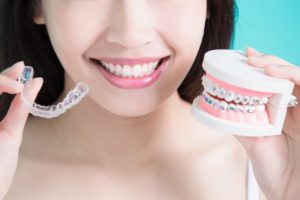
Many of us were not born with the perfectly straight smiles that movie stars always seem to have. The good news is that, in this day and age, there is no need to settle for having a smile that you don’t love. When it comes to fixing crooked teeth, there are all sorts of options, but it can be hard to select one. The most common debate is Invisalign vs. braces. Let’s talk about the benefits of each solution to help you make the decision that’s best for you.
Benefits of Traditional Braces
Braces are often the go-to option for many people, especially children and younger teenagers. They’re a classic solution that delivers several benefits, including:
- Versatility – If you have complex orthodontic issues, braces are probably the better solution for you. They allow for greater movement of the teeth than clear aligners do, making them more effective at correcting severe crookedness, overcrowding, and bite misalignment.
- A proven solution – Braces have been used in some form or fashion for centuries, but modern technology has made them more effective than ever before.
- Guaranteed compliance – Because the brackets are fixed onto the teeth, braces are ideal for patients who would forget or neglect to wear removable aligners as directed. This makes them more suitable for younger patients.
- Affordability – While many factors influence the cost of these treatments, braces are more likely than Invisalign to be covered by insurance.
Benefits of Invisalign Clear Aligners
Older teens and adults often prefer Invisalign over braces for many reasons, such as:
- Invisible – The main benefit of Invisalign is right there in the name; once you put the clear aligners on your teeth, they practically disappear. You won’t have to worry about metal brackets and wires compromising your professional image.
- Removable – Since you can take out Invisalign aligners, you’ll have an easier time cleaning the trays as well as your teeth. You also won’t have to avoid certain foods like you would with braces.
- More comfortable – No orthodontic treatment is completely without discomfort, but Invisalign exerts less pressure onto your teeth to shift them into their ideal positions. As a result, you’ll probably experience less soreness with Invisalign than you would with braces.
So, Which One Is Right for You?
Both Invisalign and braces are more suitable for patients with different orthodontic problems and lifestyles. Ultimately, the best person to help you make this decision is your dentist. Schedule a consultation with your dentist today to find out the best way for you to achieve a straight set of pearly whites that you can’t wait to show off!
About the Author
Dr. Ronald J. D’Andrea earned his Doctor of Dental Medicine degree from the University of Connecticut School of Dental Medicine. Since then, he has been elected as a Fellow of the Pierre Fauchard Academy, which recognizes and celebrates dentists who have made outstanding achievements. As a member of the American Academy of Clear Aligners, he is qualified to provide safe, effective Invisalign treatment at his Hamden, CT dental office. To learn more about the Invisalign vs. braces debate, visit Dr. D’Andrea’s website or call (203) 288-0951.






